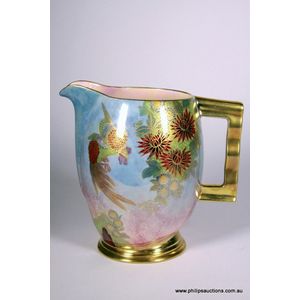"Fighting Cocks" Carlton Ware Vase
You must be a subscriber, and be logged in to view price and dealer details.
Subscribe Now to view actual auction price for this item
When you subscribe, you have the option of setting the currency in which to display prices to $Au, $US, $NZ or Stg.
- Lustre Ware - Lustre decoration on ceramics is created by painting a thin deposit of metal oxide such as gold, silver or copper onto the surface, and then firing the item again, so that metal oxide forms a thin film on the surface. The finished effect is a shiny metallic surface. The technique was used in the 19th century by potteries such as Crown Devon, Grimwades, Maling, and Royal Doulton. However the best known use was by Wedgwood for its Fairyland lustre.
- Gilding - Gilding is a method of ornamentation whereby a thin sheet of gold metal is applied to items made of wood, leather, ceramics, glass and silver for decorative purposes.
For furniture including mirrors, the sheet of gold is usually applied over a coating of gesso. Gesso is a mixture of plaster of Paris and gypsum mixed with water and then applied to the carved wooden frames of mirrors and picture frames as a base for applying the gold leaf. After numerous coats of gesso have been applied, allowed to dry and then sanded a coat of "bole", a usually red coloured mixture of clay and glue is brushed on and allowed to dry, after which the gold leaf is applied. Over time parts of the gilding will rub off so the base colour can be seen. In water gilding, this was generally a blue colour, while in oil gilding, the under layer was often yellow. In Victorian times, gilders frequently used red as a pigment beneath the gold leaf.
Metal was often gilded by a process known as fire gilding. Gold mixed with mercury was applied and heated, causing the mercury to evaporate, the long-term effect of which was to kill or disable the craftsman or woman from mercury poisoning. The pursuit of beauty has claimed many victims, not the least of which were the artists who made those pieces so highly sought after today.
This item has been included into following indexes:
- Carlton Ware (England), item types - vases and ewers 286
- Carlton Ware (England), patterns
Visually similar items

A Doulton Lambeth Florence Barlow horse decorated jug, the ovoid body with incised decoration of five galloping horses in dark and mid-brown salt glaze, blue highlights to the fine banded stiff leaf border, the conforming handle with crack, impressed and i

Coalport porcelain jug, early 19th century painted with flowers and leaves, gilt highlights. Height 20 cm

A Carlton Ware 'Fighting Cocks' jug, 1937-1941 period, pattern 4186, the baluster jug with a bracket gilt handle decorated with fowl in combat between red and blue flowers with emerald and apple green colours embellished with gilded tracery and scrolling p

Chinese champleve cloisonne vase
